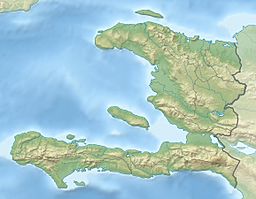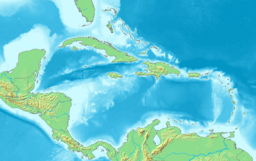Windward Passage facts for kids
Quick facts for kids Windward Passage |
|
|---|---|

The Windward Passage marked in red.
|
|
| Coordinates | 20°N 74°W / 20°N 74°W |
| Basin countries | Cuba Haiti |
| Max. width | 80 kilometres (50 mi) |
| Average depth | 1,700 metres (5,600 ft) |
The Windward Passage (which means "Passage to the Wind" in French and "Passage of the Winds" in Spanish) is a narrow stretch of ocean. It is located in the Caribbean Sea, between the islands of Cuba and Hispaniola. This passage lies specifically between the eastern part of Cuba and the northwest part of Haiti.
The Windward Passage is about 80 kilometers (50 miles) wide. It can be as deep as 1,700 meters (5,600 feet) in some places. With Navassa Island near its southern end, it connects the Atlantic Ocean to the Caribbean Sea. This makes it a very important route for ships. Ships traveling between the Panama Canal and the eastern United States often use this path. On a clear night, you can even see lights from one side of the passage to the other!
Ocean Borders and Agreements
For many years, Cuba and Haiti disagreed about exactly where their ocean border was. This is called a maritime boundary dispute. In 1977, they worked together to solve this issue. They signed an agreement called the Cuba–Haiti Maritime Boundary Agreement. This agreement officially set the boundary between their waters.
Earthquakes and the Ocean Floor
Underneath the Windward Passage, there's a big crack in the Earth's crust. This crack is called the Septentrional-Oriente fault zone. It runs from the southern coast of Cuba to the northern coast of Hispaniola. Over thousands of years, the land on either side of this fault has been slowly moving.
This fault can cause earthquakes. The last major earthquake along this fault happened in 1842. That earthquake, along with a tsunami (a giant ocean wave), caused a lot of damage to Cap-Haïtien in Haiti. Scientists still study this fault because there is a chance of future earthquakes.
In 2014, a research ship called the E/V Nautilus explored the Windward Passage. They used a special underwater robot called ROV Hercules. This expedition helped scientists learn more about how water moves through the passage. They also observed the amazing animal life living on the deep ocean floor.
See also
- Leeward Passage
 In Spanish: Paso de los Vientos para niños
In Spanish: Paso de los Vientos para niños




